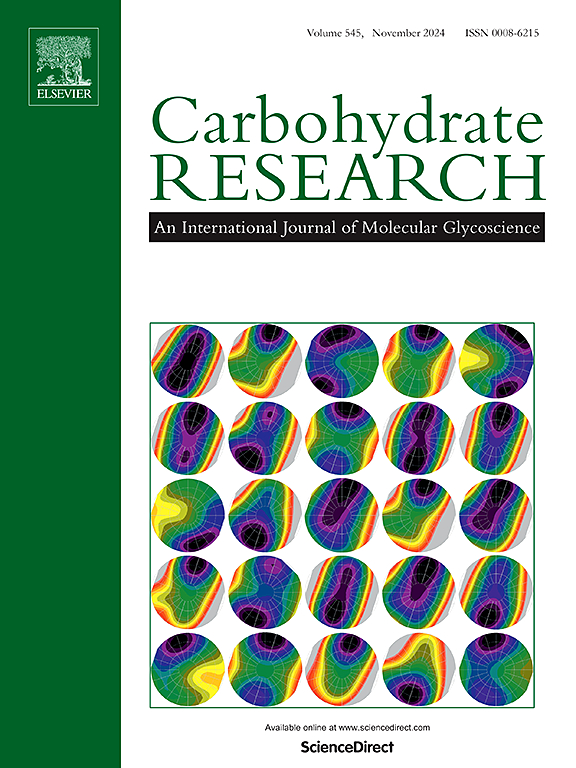薯蓣中(1→4)、(1→6)-α- d -葡聚糖的分离、结构表征及(1→4)、(1→6)-α- d -葡聚糖衍生碳点的合成和催化活性研究。
IF 2.4
3区 化学
Q3 BIOCHEMISTRY & MOLECULAR BIOLOGY
引用次数: 0
摘要
本文采用简单的微波辅助技术,以(1→4),(1→6)-α- d -葡聚糖多糖(DAPS)为原料合成碳点(CDs)。从水提物中分离得到(1→4)、(1→6)-α- d -葡聚糖,并对其结构进行了表征。采用TEM、DLS、XPS、XRD、FT-IR、TCSPC、EDX、荧光和紫外-可见光谱等分析技术对制备的高量子产率(27.70%)CDs进行了光物理和形态学表征。在我们的研究中得到的碳点(CDs)是无毒的,高水溶性的,球形的负电荷粒子,平均直径为3.28 nm。研究了碳点(cd)在日光下光催化降解污染物有机染料结晶紫(CV)的活性。碳点(CDs)在阳光下对CV的光降解效果显著(8 min内降解率达99.9%)。本文章由计算机程序翻译,如有差异,请以英文原文为准。

Isolation, structural characterization of (1 → 4), (1 → 6)-α-D-glucan from Dioscorea Alata and synthesis and catalytic activity studies of (1 → 4), (1 → 6)-α-D-glucan derived carbon dots
Herein, a straightforward, productive protocol was adopted for the synthesis of carbon dots (CDs) by a simple microwave-assisted technique from (1 → 4), (1 → 6)-α-D-glucan polysaccharide (DAPS). The isolation and structural characterization of (1 → 4), (1 → 6)-α-D-glucan from the aqueous extracting of the Diascorea Alata was described here. The photo-physical and morphological studies of the prepared high quantum yield (27.70 %) CDs were systematically characterized using different analytical techniques: TEM, DLS, XPS, XRD, FT-IR, TCSPC, EDX, Fluorescence and UV–vis spectroscopy. In our study the carbon dots (CDs) obtained are non-toxic, highly water-soluble, spherical-shaped negatively charged particles with an average diameter of 3.28 nm. The photo-catalytic activity of carbon dots (CDs) was tested under the sunlight for photo-degradation of crystal violet (CV), a pollutant organic dye. Carbon dots (CDs) showed outstanding results regarding the photo degradation of CV (achieving 99.9 % degradation within 8 min) under sunlight.
求助全文
通过发布文献求助,成功后即可免费获取论文全文。
去求助
来源期刊

Carbohydrate Research
化学-生化与分子生物学
CiteScore
5.00
自引率
3.20%
发文量
183
审稿时长
3.6 weeks
期刊介绍:
Carbohydrate Research publishes reports of original research in the following areas of carbohydrate science: action of enzymes, analytical chemistry, biochemistry (biosynthesis, degradation, structural and functional biochemistry, conformation, molecular recognition, enzyme mechanisms, carbohydrate-processing enzymes, including glycosidases and glycosyltransferases), chemical synthesis, isolation of natural products, physicochemical studies, reactions and their mechanisms, the study of structures and stereochemistry, and technological aspects.
Papers on polysaccharides should have a "molecular" component; that is a paper on new or modified polysaccharides should include structural information and characterization in addition to the usual studies of rheological properties and the like. A paper on a new, naturally occurring polysaccharide should include structural information, defining monosaccharide components and linkage sequence.
Papers devoted wholly or partly to X-ray crystallographic studies, or to computational aspects (molecular mechanics or molecular orbital calculations, simulations via molecular dynamics), will be considered if they meet certain criteria. For computational papers the requirements are that the methods used be specified in sufficient detail to permit replication of the results, and that the conclusions be shown to have relevance to experimental observations - the authors'' own data or data from the literature. Specific directions for the presentation of X-ray data are given below under Results and "discussion".
 求助内容:
求助内容: 应助结果提醒方式:
应助结果提醒方式:


